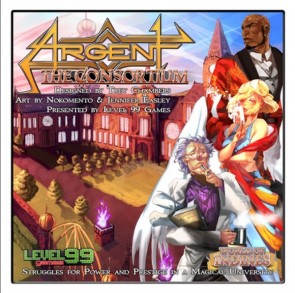Be True to Your School.
I should be writing a negative review of Argent: The Consortium because it completely flies in the face of everything I want out of board gaming in 2015. The title of the game is terrible; it speaks nothing to the Harry Potter-like “wizard’s school” setting or the themes expressed in the game. It’s a worker placement game, a tired and overplayed genre if ever there were one and it’s one of those really complicated ones at that. The game is way long and overstuffed with multiple resource types, piles of cards everywhere and built-in redundancies. The rulebook overcomplicates the mechanics and there are Euroglyphics everywhere It’s all topped off with an anime-influenced illustration style that I don’t particularly favor. The whole thing teeters on the brink of bloated inaccessibility, and you might – like I did – question if it’s worth the effort.
But it turns out that Argent: The Consortium is also one of the best worker placement games published to date. It’s a brilliant, sometimes brutal but always magical game full of dynamic interaction, thoughtful gameplay and wonderful narrative beats. There isn’t really anything else quite as bold on the market, especially in this particular genre.
Trey Chambers’ design, published by Level 99 Games is the impossible game. It should be a screaming mess appealing strictly to the kinds of folks for whom Agricola or Caverna is too streamlined. It’s a sprawling piece of work with a tremendous, almost terrifying degree of modular variety and content spilling forth everywhere. The key to its success is that everything is held together with a precise narrative logic and a direct connection between mechanic, player action and representation. It’s scary to behold at first and the first few games should definitely be regarded as “learning” ones, but once players acclimate themselves to Argent’s way of conducting business they’ll find a stunningly crafted, elaborate game that completely earns the rights to be long, complex and overflowing with components.
The setup is that each player takes on the role of a candidate aspiring to be elected to the chancellorship of Argent University, a sort of ersatz Hogwarts where the curriculum includes Planar Studies, Sorcery and other forms of magic. There are twelve voters (the titular consortium) that will each cast a vote for the candidate that matches their criteria and the player that gets the most votes, obviously, wins the game. But the catch is that apart from two electors present in every game, the voters’ criteria are kept secret and part of the game is discovering what each is looking for in their ideal chancellor. Depending on the character, they may vote for the candidate with the most gold, the most assets of a particular type of magic, or the most artifacts. These secret voters, when discovered by the players, act almost like secret objective cards in other games. They provide the player with clear strategic goals and serve to shape the possible paths to victory.
Process is actually quite simple. It’s just that it’s one of those designs where there are a hundred things to consider at once. On your turn, you either place one of your Mages- each color-coded to one of the schools of magic- into a room tile where there is an available space or you take a Bell Tower card, which typically gives you some kind of a benefit such as taking the first player token for initiative. Once the Bell Tower cards are depleted, the University tiles are resolved in order and players collect whatever resources or assets they gain from their position in the room- fairly standard worker placement stuff.
But it’s when you place a Mage that this game really starts to distinguish itself from its peers. Each Mage has a function based on its color. Sorcerous red Mages get to zap another player’s Mage to the infirmary, knocking them out of their position and sidelining them for the turn, barring another effect that heals them up. Green Mages might have enhanced fortitude, rendering them immune to other players’ attacks. And the Planar Studies Mages might get to use a special “shadow” slot next to an occupied place in a room. You draft these mages at the beginning of the game so that you always have two of your candidates color and three of any other colors, so who you pick to be in your coterie has a huge effect on what you can do during the game.
So the worker placement element has more teeth than many might expect, and in fact it takes some adjustment to get used to the fact that anyone can pull a wand on another Mage and shoot them into traction. You’re not guaranteed that your placement is going to come to fruition unless you have some kind of protection, and it can even happen that all of your Mages wind up nursing wounds and you spend the turn collecting a consolation prize. What’s more, there is a finer detail in placing your Mages because even though the top slot tends to have the best reward, you might actually want something lower- maybe a Research or Wisdom token, mana or gold, or a combination of the above.
But the most important aspect of this mechanic is that when you place Mages, it makes narrative sense. When they go Adventuring, it’s easy to connect the rewards to the action. Likewise, going to the Council Chamber to sway supporters to your cause is definitely more concrete than getting a colored cube representing a resource that you will eventually use to make another cube of another resource. Of course you get magic items, potions and other treasures on a trip down to the vault. Even in an eight room, three player game it always feels like there is tons to do, and all of it contributes to the story this game is telling.
It’s almost overwhelming at first. You’re constantly concerned with obtaining Marks, which you use to discover an elector’s criteria. But then you’ve got to concern yourself with researching spells from a big, fat stack of cards. Each requires Wisdom and Research resources, and each one has its own upgrade path with stronger effects. But then you need mana to power those spells, so some workers need to do things that generate that. Maybe you know that an elector will give a vote to the player with the most supporters (which are themselves action cards with a variety of effects), so that means spending time in the Council Chamber. And then you need to worry about accruing Influence points, which are a measure of your overall popularity at the school. Don’t forget earning Merit Badges, which grant you the ability to use special, privileged spots in the rooms.
Every game is just packed full of these elements. Each game offers a different set of electors, which is just one of the ways this game completely embraces the “different each time” mantra. The university is also different every game with 8 to 12 room tiles randomly selected and placed based on the number of players. Some games may have the Archmage’s Study but not the Vault, for example, and the effects on available actions are tremendous. And then each of the room tiles has two sides with different functions, an “A” side that is a little more straightforward and a more advanced “B” side. In addition, each candidate has two sides that correspond to two different starting spells. Beyond that (whew), each Mage power has an A and a B side as well, so their placement powers vary each game.
All of the above results in games where there is tons of mana but no gold. Or ones where everyone has a ton of artifacts but nobody is really researching spells. And then there are games where everyone is just spell-slinging and playing a vicious take-that style strategy and others where there is gentler skullduggery and intrigue. It’s a wild ride no matter what mix of variables are in play, but this kind of variety means that there is a lot of repetition in the game. There’s multiple ways to make money, lots of cards duplicate certain effects between spells, potions and magic abilities. Some rooms feel redundant. I was bothered by it at first, but it became apparent that the repetition is really a design necessity to prevent games from crapping out or locking down when there’s a resource all but excluded from the available options.
The bottom line is that this sprawling, table-consuming masterpiece works and it’s spectacularly entertaining and thoughtfully composed. I haven’t run into a situation that I thought was out of balance or screwy. Beneath all of the narrative gloss and chromed-out setting, it’s a pretty finely tuned machine that pulls off the neat trick of running like clockwork while never foreclosing on player agency, interaction or possibility.
But wait, there’s more. There has been one major expansion released as of this writing, the ‘Mancers of the University. At first, I was reticent to add more content to a game already packed to the gills with it, but after using it I’m convinced that anyone interested in this game should look toward implementing it after the first four or five games. The expansion adds a new magic school (Technomancy) that augments and supports the research component of the game along with several fun, modular add-ons that I wouldn’t want to do without at this point. There are scenario cards that replace the standard five round cards in the base game that give the entire affair a different flavor- there’s even one where players can assassinate the voters. The Bell Tower cards get a huge boost, increasing their attractiveness and utility for players who opt to choose one instead of placing a Mage. More rooms, more spells and more of everything good. The modular add-ons are a la carte, completely optional and all great. It very much feels like content that “belongs” in the base game, but may have been extracted because there was already so much there.
With a Harry Potter license, this game would be one of my all-time favorites. I’ll take Severus Snape over “Larimore Burman” every time. But that’s wishful thinking, and what we have is Argent: The Consortium. The title sounds like a grim, cyberpunk business game and not the colorful, magical campus life fantasy presented here. Regardless of what they called it, Argent is a compelling, vibrant game that even those who have sworn off the worker placement genre should have a look at. Best in class, indeed.
 Games
Games How to resolve AdBlock issue?
How to resolve AdBlock issue? 



















